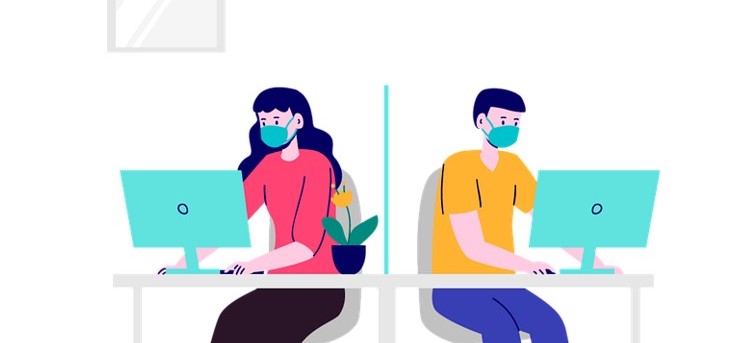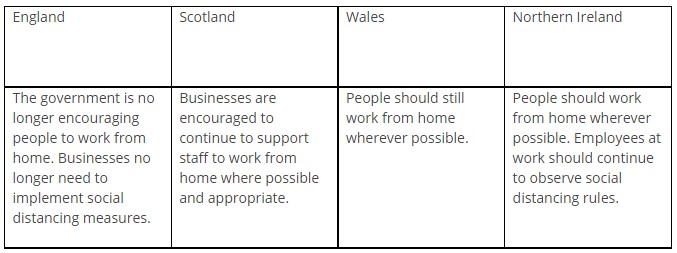Back to the workplace: Are you prepared?

|
Contents |
[edit] Introduction
Throughout July and August 2021, the regulations and guidance for work have been modified across the UK. Particularly in England, people are no longer being instructed by the Government to work from home where possible.
[edit] Guidance on working from home
From across the UK, as people return to work, BSRIA has received queries from members and clients on three key topics:
- How can we give assurance to our building occupants that the indoor air quality is of a standard that will mitigate COVID-19 transmission?
- What are my water systems going to be like after more than a year of underuse?
- How can we address the concerns of our building occupants?
[edit] Ventilation
As of September 2021, there are no regulations specifically addressing ventilation during the pandemic, but reliable guidance is available. Across the board, the guidance to increase fresh air remains in place. In this context, fresh air is taken to mean: outdoor air as it is unlikely to have any COVID-19 contamination. Where contamination risks are present, further mitigation may need to be considered.
A level of pragmatism, supported by a structured risk assessment and analysis process, should inform the approach to ventilation. Providing adequate ventilation does not mean people have to work in an uncomfortably warm or cold workplace; a safe level of ventilation needs to be balanced with thermal comfort and the occupants’ wellbeing.
There are some useable metrics that can be applied in any building (or other enclosed space) to indicate the efficacy and suitability of the ventilation strategy. On the 23 October 2020, SAGE-EMG published guidance on the “Role of Ventilation in Controlling SARS-CoV-2 Transmission”. This paper gave guidance on the CO2 levels that are considered as indicators of adequate ventilation to mitigate transmission. Both CIBSE in the UK and REHVA in Europe have given indications of CO2 levels in their guidance documents:
- CIBSE V5 - COVID-19: Ventilation (v5)
- REHVA V4.1 – REHVA COVID19 GUIDANCE
These are summarised in the table below.
BSRIA is supporting members and clients with a COViD-19 Ventilation Verification Service. The base-level service establishes conformance with existing guidance, and the enhanced service also includes measurement of airflow rates, VOC levels, pathogen levels in ventilation equipment and occupied spaces. BSRIA’s tracer gas decay rate checks can establish occupancy levels based on the ventilation provision to specific spaces and an agreed level of desired ventilation provision for the space.
[edit] Water safety including water safety plans
With so much going on during the 2020/2021 pandemic, it is not surprising that it is only now that we are starting to get requests for support in implementing the water safety plans from BS 8680:2020. The water safety in a building is focused primarily on Legionella and its prevention. Fortunately, many of the myriads of other pathogens that can be found and are able to proliferate in water can be controlled by the same maxim:
“Keep the hot hot, keep the cold cold and keep it moving.”
Due to the changes in use that many buildings have undergone during the pandemic, water use may have diminished for a prolonged period. BSRIA’s article “Planning for water safety in buildings and workplaces” comprehensively explains the holistic considerations that building owners and managers need to make to maintain wholesome water supplies in their buildings.
Prudence dictates that the cautious approach to the “return to the workplace” would include some testing and sampling of the water in the system. Sentinel points (start, middle and end of the system) give a good range for sampling, where testing every point is cost-prohibitive.
When BSRIA undertakes this service, not only are biological elements inspected but water composition is also investigated. Atypical levels of dissolved solids can be indicative of the system’s health. This is achieved by analysing the types of material in the samples. Excessive metal oxides can indicate corrosion in the system, inhibitor levels can be analysed to ensure they are correct for the system type and of course biological content can be discerned.
After a period of inactivity, it is not just domestic systems that need to be checked. Closed water systems, such as heating, may have undergone excessive corrosion or settling of sediment. Non-destructive testing methods such as ultrasonic thickness testing can give spot check indications of system integrity against installation standards, or over a period of time, the maintenance or deterioration of the system’s pipework.
Valves may need to be eased and released due to inactivity. Care should be taken when performing this as this action may instigate issues with the valves. If multiple valves show similar issues, a destructive investigation of the valve may be considered to determine the cause. Water system examination services may include:
- Ultrasonics.
- Water composition analysis.
- Endoscopy.
- System history review.
- Visual examination of system samples.
- Flow rate measurements.
- Thermal Imaging.
- Water safety plans.
[edit] BSRIA occupant wellbeing return to work survey (BOW survey)
People are complicated. We all have individual needs, expectations and desires. If building owners and managers are looking for a way to meet all or most of them, they will need to know what those needs, expectations and desires are.
When the workforce consists of a handful of people, this is easily achieved. When we start to look at tens and hundreds of people or even thousands, there is more need for structure.
Supporting building owners in following government advice and involving the workforce, or other building occupants, in the return to work process, BSRIA experts have developed a remotely deliverable survey known as the BOW (BSRIA Occupant Wellbeing) survey. This survey gathers information from the employees or other building occupants about what their focus of concern is. This allows occupants of the building to have their voices heard and gives facilities teams guidance for the areas of focus.
Building on the expertise and database gathered from the BOW survey, used by many to support Post Occupancy Evaluation (POE), BSRIA’s BOW return to work survey provides an opportunity for the occupants to express their concerns about coming back to the workplace. The survey also provides analysis and presentation of gathered data in a graphical format. Optional detailed reporting on the results obtained can enhance the benefits gained from rolling out this survey.
BSRIA consultants are keeping abreast with “back to the workplace” considerations. For more information, call +44 (0) 1344 465578 or write to: consultancy@bsria.co.uk.
This article originally appeared on the BSRIA website. It was published in September 2021.
--BSRIA
[edit] Related articles
- BS 8680:2020 Water quality. Water Safety Plans. Code of practice.
- BSRIA articles on Designing Buildings Wiki.
- Building ventilation and COVID-19 transmission risk.
- Designing HVAC to resist harmful pathogenic microorganisms (bacteria and viruses such as influenza and 2019-nCov).
- Heating ventilation and air conditioning HVAC.
- HVAC industry defines post COVID-19 changes.
- Planning for water safety in buildings and workplaces.
- SAGE EMG guidance on ventilation and COVID-19.
- Standalone: The new way forward in non-domestic ventilation.
- Ventilation.
- Ventilation and control of COVID-19 transmission.
- Water safety plan WSP.
[edit] External resources
Featured articles and news
One of the most impressive Victorian architects. Book review.
RTPI leader to become new CIOB Chief Executive Officer
Dr Victoria Hills MRTPI, FICE to take over after Caroline Gumble’s departure.
Social and affordable housing, a long term plan for delivery
The “Delivering a Decade of Renewal for Social and Affordable Housing” strategy sets out future path.
A change to adoptive architecture
Effects of global weather warming on architectural detailing, material choice and human interaction.
The proposed publicly owned and backed subsidiary of Homes England, to facilitate new homes.
How big is the problem and what can we do to mitigate the effects?
Overheating guidance and tools for building designers
A number of cool guides to help with the heat.
The UK's Modern Industrial Strategy: A 10 year plan
Previous consultation criticism, current key elements and general support with some persisting reservations.
Building Safety Regulator reforms
New roles, new staff and a new fast track service pave the way for a single construction regulator.
Architectural Technologist CPDs and Communications
CIAT CPD… and how you can do it!
Cooling centres and cool spaces
Managing extreme heat in cities by directing the public to places for heat stress relief and water sources.
Winter gardens: A brief history and warm variations
Extending the season with glass in different forms and terms.
Restoring Great Yarmouth's Winter Gardens
Transforming one of the least sustainable constructions imaginable.
Construction Skills Mission Board launch sector drive
Newly formed government and industry collaboration set strategy for recruiting an additional 100,000 construction workers a year.
New Architects Code comes into effect in September 2025
ARB Architects Code of Conduct and Practice available with ongoing consultation regarding guidance.
Welsh Skills Body (Medr) launches ambitious plan
The new skills body brings together funding and regulation of tertiary education and research for the devolved nation.
Paul Gandy FCIOB announced as next CIOB President
Former Tilbury Douglas CEO takes helm.

























